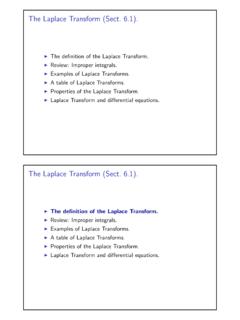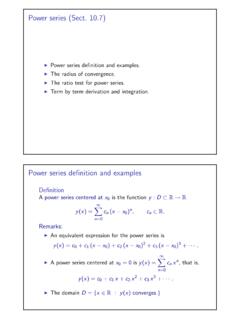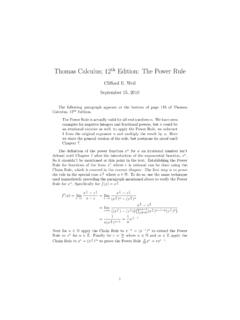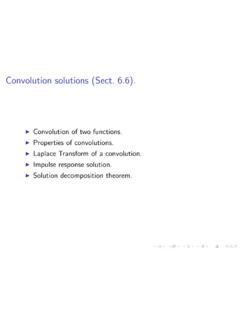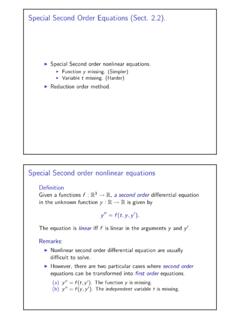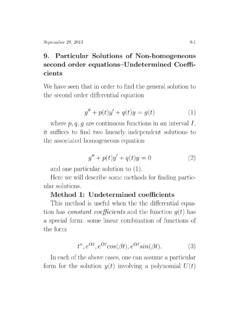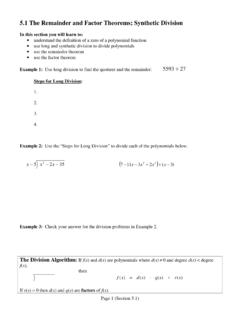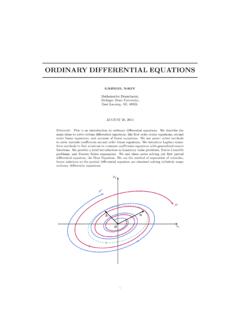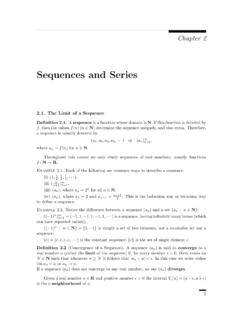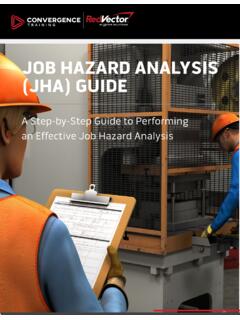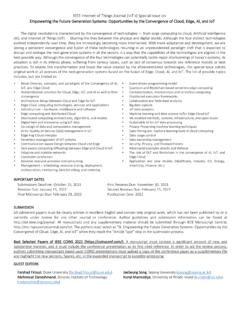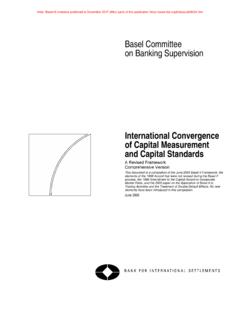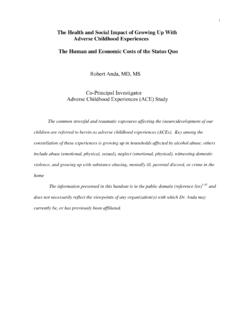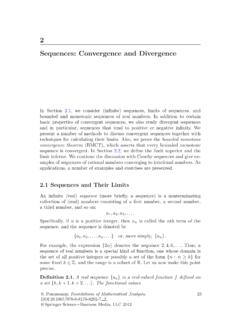Transcription of Convergence of Taylor Series (Sect. 10.9) Review: Taylor ...
1 Convergence of Taylor Series (Sect. )IReview: Taylor Series and Taylor the Taylor the : Taylor Series and polynomialsDefinitionTheTaylor seriesandTaylor polynomialorderncentered ata Dof a differentiable functionf:D R Rare given byT(x) = k=0f(k)(a)k!(x a)k,Tn(x) =n k=0f(k)(a)k!(x a) :IThe Taylor Series may or may not (x) =f(a) +f (a) (x a)is the linearization Taylor polynomial is called of orderninstead of degreen,becausef(n)(a)may particular casea= 0 is called theMaclaurin seriesandthen+ 1 Maclaurin polynomial, of Taylor Series (Sect. )IReview: Taylor Series and Taylor the Taylor the Taylor TheoremRemark:The Taylor polynomial and Taylor Series are obtainedfrom a generalization of the Mean Value Theorem:Iff: [a,b] Ris differentiable, then there exitsc (a,b) such thatf(b) f(a)(b a)=f (c) f(b) =f(a) +f (c) (b a).Theorem ( Taylor s Theorem)If f: [a,b] Ris(n+ 1)-times continuously differentiable, thenthere there exists c (a,b)such thatf(b) =f(a) +f (a) (b a) +f (a)2(b a)2+ +f(n)(a)n!
2 (b a)n+f(n+1)(c)(n+ 1)!(b a)n+ Taylor TheoremRemark:The Taylor Theorem is usually applied for a fixed pointa,while the pointb=xis used as an independent variable:f(x) =f(a) +f (a) (x a) + +f(n)(a)n!(x a)n+Rn(x)where theremainder functionRnis given byRn(x) =f(n+1)(c(x))(n+ 1)!(x a)n+1,withc (a,x).Remark:The pointc (a,x)also depends :We can use the Taylor polynomial to write thatf(x) =Tn(x) +Rn(x).The Taylor TheoremCorollaryLet f:D Rbe infinitely differentiable with Taylor polynomialsTnand remaindersRn, that is, for n>1holdsf(x) =Tn(x) +Rn(x).IfRn(x) 0as n for x D , then the Taylor Series centeredat x=a converges on D to the function values f(x),that is,f(x) = n=0f(n)(a)n!(x a) :Without knowingc(x) it is often possible to estimateRn(x) =f(n+1)(c(x))(n+ 1)!(x a)n+ of Taylor Series (Sect. )IReview: Taylor Series and Taylor the Taylor the the Taylor seriesExampleShow that the Taylor Series off(x) =excentered ata= 0converges :Sincef(n)(x) =exanda= 0,thenf(n)(0) = 1,andex= 1 +x+x22+x33!
3 + +xnn!+Rn(x),whereRn(x) =ec(x)xn+1(n+ 1)!.Sincef(x) is increasing,|Rn(x)|=ec(x)|x|n+1(n+ 1)!6e|x||x|n+1(n+ 1)! 0,asn .for everyx n=0xnn!= 1 +x+x22+x33!+ .CUsing the Taylor seriesExampleFind the Taylor Series off(x) =ex2centered ata= :We use the Taylor seriesey= n=0ynn!fory=x2,ex2= n=0(x2)nn!= n=0x2nn!= 1 +x2+x42+x63!+ .CExampleFind the Taylor Series off(x) =e x2centered ata= :We substitutex2by (x2) in the example above,e x2= n=0( x2)nn!= n=0( 1)nx2nn!= 1 x2+x42 x63!+ .CUsing the Taylor seriesExampleFind the Taylor Series off(x) =3x2(1 x)3ata= 0 on ( 1,1).Solution:The straightforward way is to compute the derivativesf(n)(x).A simpler ways is to realize thatf(x) = 3x2[1(1 x)3]= 3x212[1(1 x)2] =32x2[1(1 x)] Recall that for|x|<1 holds11 x= n= ,f(x) =32x2[ n=0xn] =32x2 n=2n(n 1)xn 2=32 n=2n(n 1) conclude:f(x) =32[2x2+ (3)(2)x3+ (4)(3)x4+ ].CUsing the Taylor seriesExampleFind the Taylor Series off(x) = cos(2 x) ata= 0 on ( 1,1).
4 Solution:Ify(x) = cos(x),y (x) = sin(x),y (x) = cos(x),y (x) = sin(x),y(4)(x) = cos(x),and then the derivatives repeat,y(0) = 1,y (0) = 0,y (0) = 1,y (0) = 0,y(4)(0) = ,cos(x) = 1 x22+x44! x66!+ = n=0( 1)nx2n(2n)!.Substitutexby 2 xabove,cos(2 x)= n=0( 1)n(2 x)2n(2n)!.cos(2 x)= n=0( 4x)n(2n)!= 1 4x2!+(4x)24! (4x)36!+ .CConvergence of Taylor Series (Sect. )IReview: Taylor Series and Taylor the Taylor the the remainderTheoremLet f:D Rbe infinitely differentiable with Taylor polynomialsTnand remaindersRncentered at a D , that is, for n>1holdsf(x) =Tn(x) +Rn(x).If|f(n+1)(y)|6 Mfor all y such that|y a|6|x a|, then|Rn(x)|6M|x a|n+1(n+ 1)!.Furthermore, if the inequality above holds for every n>1, then theTaylor Series T(x)converges to f(x).Estimating the remainderExampleEstimate the maximum error made in approximatingf(x) =exbyT2(x) = 1 +x+x22over the interval [ 2,2].Solution:We use the formula|Rn(x)|6M|x a|n+1(n+ 1)!
5 ,fora= 0,whereMsatisfies|f(n+1)(y)|6M,for|y|6|2 0|= (x) =ex,andn= 2,andf(3)(x)=ex,then|f(3)(y)|6e2=Mfor|y 0|6|2 0|= , the smallest bound forR2in [ 2,2] is|R2(x)|6e2|x|33!6e226 |R2(x)|
